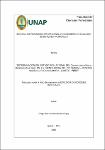| dc.contributor.advisor | Álvarez Vásquez, Luis Fernando | |
| dc.contributor.author | Hernández Rojas, Diego Patricio | |
| dc.date.accessioned | 2017-02-28T15:12:50Z | |
| dc.date.available | 2017-02-28T15:12:50Z | |
| dc.date.issued | 2016 | |
| dc.identifier.uri | http://repositorio.unapiquitos.edu.pe/handle/20.500.12737/4199 | |
| dc.description.abstract | En los hábitats amazónicos los caimanes cumplen un rol importante, contribuyendo al flujo de nutrientes entre los ecosistemas acuáticos y terrestres. Es por ello que el objetivo de este estudio fue evaluar el estado poblacional de Caiman crocodilus y Melanosuchus niger en la cuenca media del río Samiria, en tres zonas de estudio (Ungurahui, Wishto–Yanayacu y Tacshacocha), mediante la estimación de sus abundancia, y su distribución en los diferentes cuerpos de agua de la cuenca media del río Samiria. Las evaluaciones se realizaron mediante conteos nocturnos en transectos acuáticos. La abundancia de Caiman crocodilus fue de 0.35 ind/km en Ungurahui y Wishto – Yanayacu y 0.52 en Tacshacocha, para Melanosuchus niger fue 0.09 en Ungurahui, 0.53 en Wishto – Yanayacu y 0.74 en Tacshacocha, registrando diferencia significativa en las abundancias de Melanosuchus niger (p=0.0302). La distribución en cuerpos de agua mostró que ambas especies tienen una abundancia predominante en el caño para la zona de Ungurahui, mientras que en Wishto-Yanayacu Caiman crocodilus fue más abundante en río y Melanosuchus niger lo fue en el lago, en la zona de Tacshacocha ambas especies tienen una abundancia predominante en el río.
Se concluye que ambas especies se encuentran en buen estado poblacional sin embargo las abundancias registradas son bajas en comparación a otras zonas de la Amazonía como en los ríos de Madre de Dios y Parque Nacional del MANU, asimismo ambas especies son simpátricas en cuanto a hábitats y se reportó la mayor abundancia en la zona de Tacshacocha para ambas especies, seguido de Wishto–Yanayacu y Ungurahui respectivamente. | es_PE |
| dc.description.abstract | In the Amazonian habitats alligators play an important role contributing to the flow of nutrients between aquatic and terrestrial ecosystems. In this study the population status of C. crocodilus and M. niger was evaluated in three areas (Ungurahui, wishto-Yanayacu and Tacshacocha) of the middle basin of the Samiria river, by estimating their abundance and distribution in the different waterbodies of the middle basin of the Samiria river. Evaluations were carried out by nocturnal counting in aquatic transects. The abundance of C. crocodilus was 0,35ind/km in Ungurahui and Wishto-Yanayacu and 0,52 ind/km in Tacshacocha; for M. niger was 0,09 ind/km in Ungurahui, 0,53 ind/km in Wishto-Yanayacu and 0,74 ind/km in Tacshacocha, registering significant difference in the abundances of M. niger (p = 0,0302). The distribution in water bodies showed that both species have predominant abundance in the streams of Ungurahui area, while in Wishto-Yanayacu C. crocodilus was more abundant in river and M niger was in the lake; in the Tacshacocha area both species have predominant abundance in the river. In conclusion, both species are in good population status, however abundances registered are low compared to other areas of the Amazonia like the rivers of Madre de Dios and Manu National Park; also both species are sympatric in terms of habitat and the highest abundance was reported in the area Tacshacocha for both species, followed by Wishto- Yanayacu and Ungurahui respectively. | en_US |
| dc.description.uri | Tesis | es_PE |
| dc.format | application/pdf | es_PE |
| dc.language.iso | spa | es_PE |
| dc.publisher | Universidad de la Amazonía Peruana | es_PE |
| dc.rights | info:eu-repo/semantics/openAccess | es_PE |
| dc.rights | Attribution-NonCommercial-NoDerivs 3.0 United States | * |
| dc.rights.uri | http://creativecommons.org/licenses/by-nc-nd/3.0/us/ | * |
| dc.source | Universidad Nacional de la Amazonía Peruana | es_PE |
| dc.source | Repositorio institucional - UNAP | es_PE |
| dc.subject | Lagarto blanco | es_PE |
| dc.subject | Caiman crocodilus | es_PE |
| dc.subject | Lagarto negro | es_PE |
| dc.subject | Melanosuchus niger | es_PE |
| dc.subject | Hábitad | es_PE |
| dc.subject | Abundancia | es_PE |
| dc.title | Determinación del estado poblacional del Caiman crocodilus y Melanosuchus niger en la cuenca media del río Samiria – Reserva Nacional Pacaya Samiria - Loreto - Perú. | es_PE |
| dc.type | info:eu-repo/semantics/bachelorThesis | es_PE |
| thesis.degree.discipline | Ingeniería en Ecología de Bosques Tropicales | es_PE |
| thesis.degree.grantor | Universidad Nacional de la Amazonía Peruana. Facultad de Ciencias Forestales | es_PE |
| thesis.degree.level | Título Profesional | es_PE |
| thesis.degree.name | Ingeniero en Ecología de Bosques Tropicales | es_PE |
| thesis.degree.program | Regular | es_PE |


